Alpha Centauri is a triple star system. It is the closest star and planetary system to our Solar System.
Key Facts & Summary
- Alpha Centauri was discovered in 1915, while it’s only confirmed planet, Proxima Centauri b, was discovered in 2016 and it is the closest exoplanet to us.
- The two main stars Alpha Centauri A and B form a binary pair and are 4.3 light-years away from Earth. They are also named Alpha Centauri AB. To the naked eye, they appear to be one single star.
- They form the brightest star in the southern constellation of Centaurus and the third brightest in the night sky, outshone only by Sirius and Canopus.
- The third star, Proxima Centauri is 4.2 light-years away from Earth, making it the closest star to us with the exception of the Sun.
- Both Alpha Centauri A and B are Sun-like stars while Proxima Centauri is a small and faint red dwarf.
- Alpha Centauri A has 1.1 times the mass of the Sun and 1.519 times its luminosity.
- Alpha Centauri B is smaller and cooler at 0.907 times the Sun’s mass and 0.445 times its luminosity.
- Proxima Centauri has a mass of 0.1221, and it is 20.000 times fainter than our Sun.
- Alpha Centauri A and B orbit around a common center with an orbital period of almost 80 years. They have an elliptical orbit which is a bit eccentric. The distance between A and B varies from 35.6 AU to 11.2 AU. The average distance between A and B is about 23 AU.
- The current distance between Alpha Centauri AB and Proxima Centauri is about 13.000 AU. This is equivalent to about 430 times the radius of Neptune’s orbit.
- Proxima Centauri b has an orbital period of about 11.2 Earth days.
- It is not yet known if this exoplanet is habitable, but conditions seem harsh.
- There are many proposed exoplanets orbiting in the Alpha Centaury system, but many have been rejected.
Since it is the third brightest star in the night sky, Alpha Centauri was observed for hundreds of years. It is listed in the 2-nd century star catalog of Ptolemy since it was easily observable in that period of time from Alexandria, Egypt.
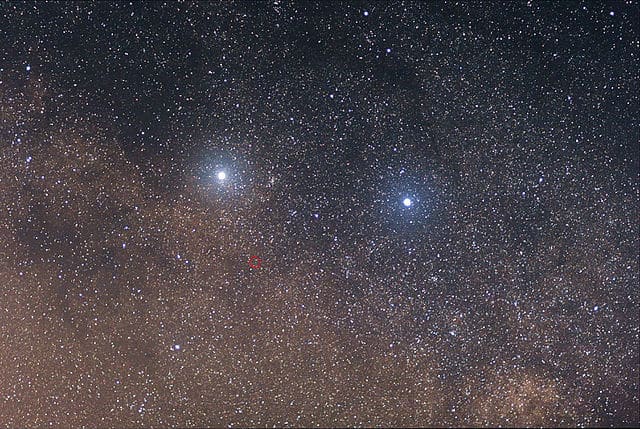
An English explorer, Robert Hues, brought Alpha Centauri to the attention of European observers in his 1592 work “Tractus de Globis”, along with Canopus and Achernar.
Later, the binary nature of Alpha Centauri AB was recognized in 1689 by Jean Richaud, while observing a comet. By this point, Alpha Centauri was only the second binary star to be discovered, preceded by Acrux.
Later, a small controversy occurred. The motion of the binary stars was calculated but was not released until 1833. In the same year, another astronomer released his own accurately determined parallax for 61 Cygni. Because of this, Alpha Centauri is sometimes considered as the second star to have its distance measured.
In 1834 John Herschel began the first micrometrical observations and by 1915, Robert Innes discovered Proxima Centauri by blinking photographic plates taken at different times during a proper motion survey suggesting that the star is also part of the binary system.
The orbits were calculated in 1926 and refined until 2002, and by late 2016, the exoplanet Proxima Centauri B was discovered.
Alpha Centauri A & B
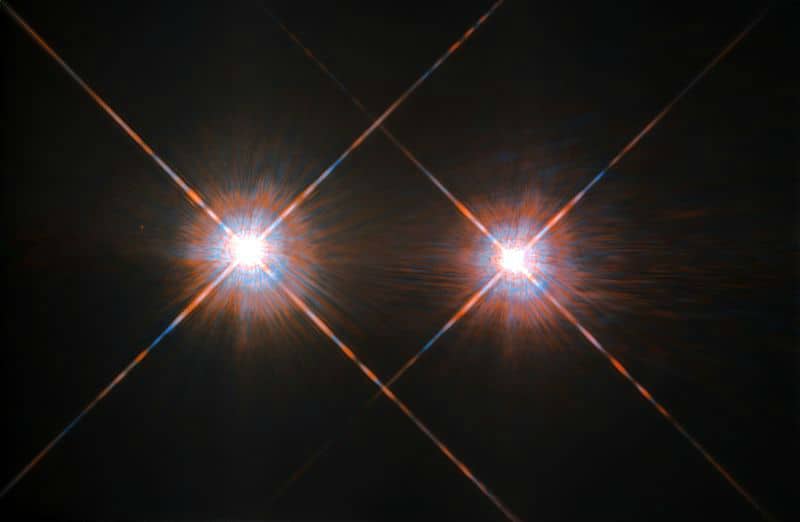
Alpha Centauri A is also named Rigil Kentaurus which translates to “the foot of the Centaur” – is the principal member – primary – of the binary system. It is a Sun-like star, class G, with a similar yellowish-color, whose stellar classification is spectral type G2 V.
It is more luminous than our Sun, having 10% more mass than it. Its radius is 22% larger, being the fourth brightest star in the sky, excluding the Sun.
The magnetic activity is comparable to that of our star, showing coronal variability due to starspots, as modulated by the rotation of the star.
Alpha Centauri B is also named Toliman, meaning “the two male Ostriches” in Arabic. It is the secondary star of the binary system, being a star of spectral type K1 V. This makes it more orange in color than Alpha Centauri A. It is smaller, having 90% of the Sun’s mass, and a 14% smaller diameter. Though it is dimmer than A, it emits more energy in the X-ray band.
At least one flare has been observed in Alpha Centauri B, it is magnetically active, even more so than Alpha Centauri A.
Binary System
To the naked eye, they appear to be one single star, since they are relatively close and are the brightest in the southern constellation of Centaurus.
They can easily be seen with binoculars or small telescopes. They orbit a common center of gravity once every 80 years. Since the third star, Proxima Centauri, is 13.000 AU away from the binary system, it is considered to be outside it.
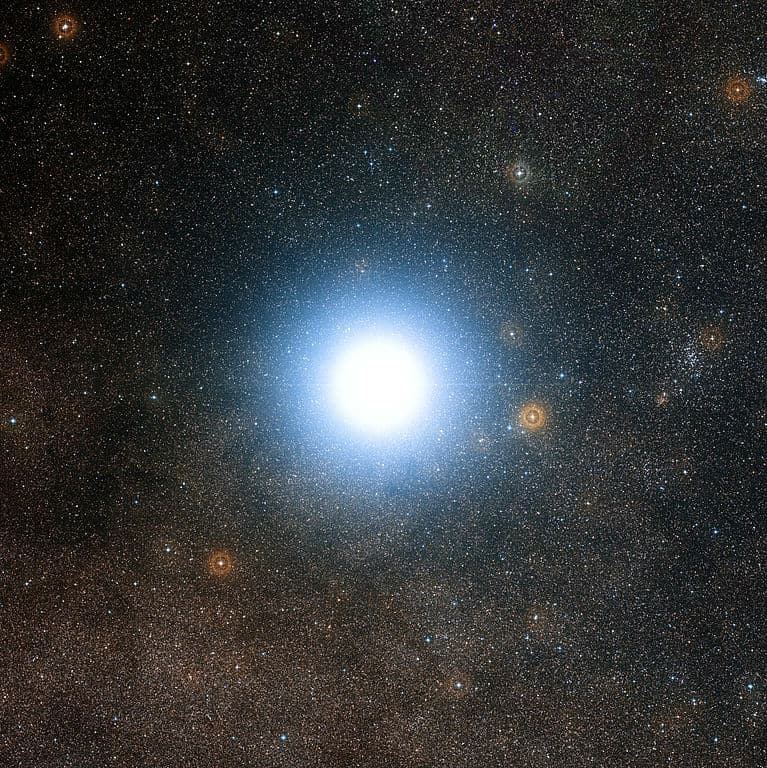
However, studies conducted in 2017 have shown that this star is also somewhat gravitationally bound to the others. The orbits of A and B are moderately eccentric with their closest approach/periastron being 11.2 AU or 1.68 billion km / 1.04 billion mi, or the distance between the Sun and Saturn.
Their recent periastron occurred in August 1955 and the next will happen in 2035. Their furthest separation/apastron is about 35.6 AU, almost the same distance between Pluto and the Sun. Their recent apastron occurred in May 1955 and the next will occur in 2075.
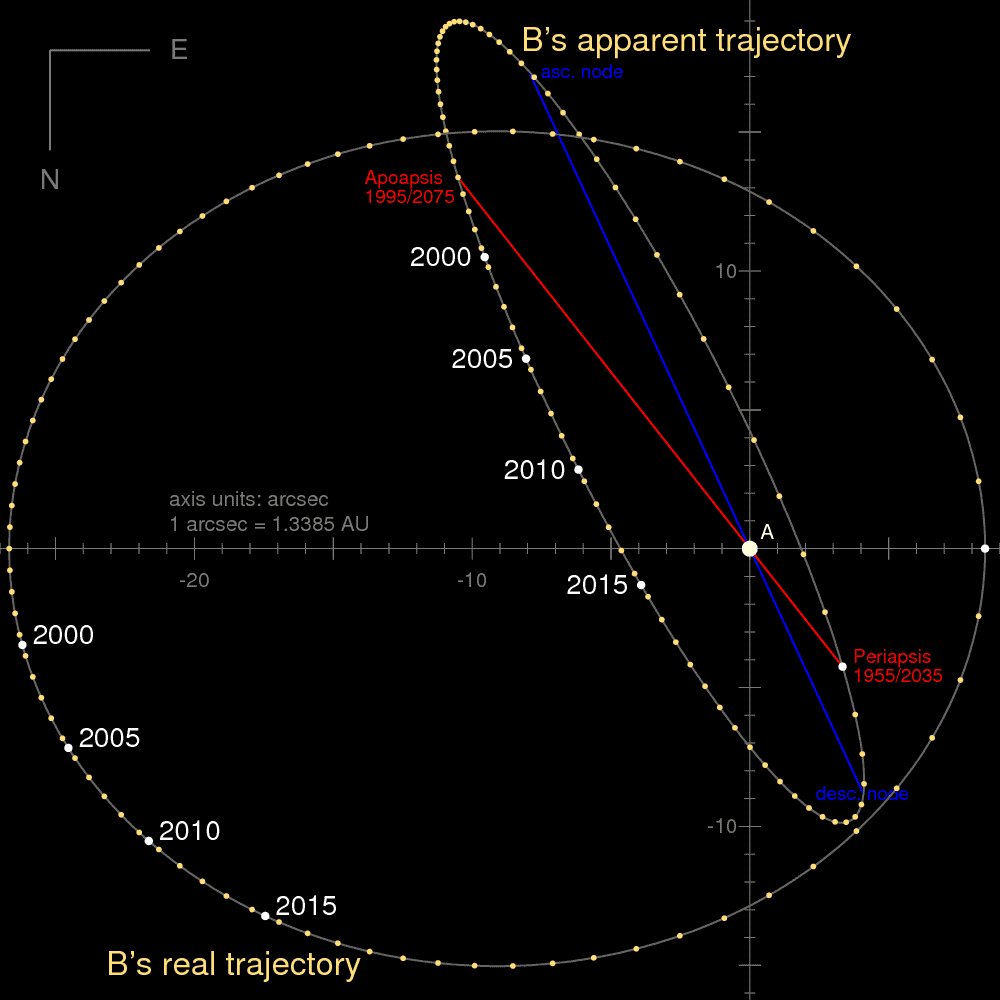
Alpha Centauri C
Better known as Proxima Centauri, is a small main-sequence red dwarf of spectral class M6 V. It’s more than 20.000 times fainter than our Sun, less than 1%, having only 12% of its mass. Its distance from A and B is equivalent to 0.21 light-years or 1.9 trillion km / 1.2 trillion mi, almost 5% the distance between Alpha Centauri AB and the Sun.
The orbital period of Proxima Centauri is about 547.000 years (+ 6.600 years or – 4.000 years). It has an eccentric orbit greater than Mercury. Proxima Centauri’s periastron comes within 4.300 AU ( +1.100 or – 900), and its apastron occurs at 13.000 AU ( + 300 or – 100).
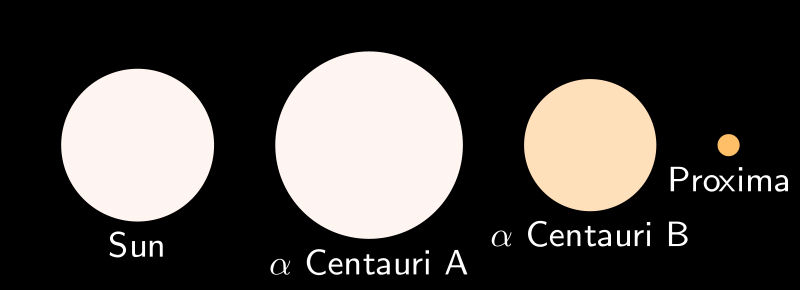
Proxima Centauri is only 55% as hot as the Sun.
It is believed that Alpha Centauri is similar or even older than our Sun. The star system is about twice in mass as the sun and the absolute magnitudes of A-B are about + 4.38 and +5.71, respectively. Proxima Centauri, on the other hand, it is far too dim to be seen with the naked eye.
Proxima Centauri b
Up until now, it is the only confirmed exoplanet of the Alpha Centauri system. Many more are speculated to be present but have yet to be confirmed.
It is orbiting in the habitable zone of the red dwarf star Proxima Centauri, the closest star to the solar system which makes it, in turn, the closest exoplanet to the solar system.
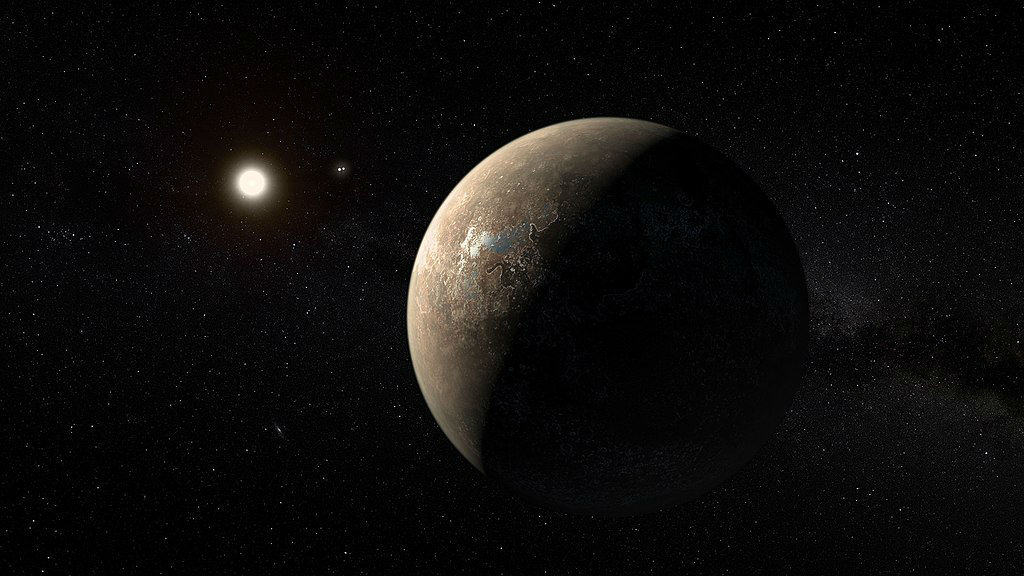
It is located at 4.2 light-years / 1.2 parsecs / 40 trillion km or 25 trillion mi from Earth. It orbits Proxima Centauri at a distance of 0.05 AU or 7.5 million km / 4.6 million mi.
It has an orbital period of about 11.2 Earth days. It has an estimated mass of 1.3 times that of Earth. It is not yet known how habitable it is but the planet is subjected to stellar wind pressures of more than 2.000 times those experienced by Earth from the solar wind, due to its closeness.
The planet was discovered in 2016 by the use of the radial velocity method, where periodic Doppler shifts of spectral lines of the host star suggest an orbiting object. Its exact mass is difficult to calculate but statistically, there is a 90% chance that the planet’s mass is less than three times that of Earth. Much of this planet still remains a mystery.
Future plans
Since it is so close to us, the Alpha Centauri system will remain closely studied. The only planet detected has made enthusiasts striving for the discovery of possible other exoplanets in this system.
Many have been proposed but have yet to be confirmed. Since Proxima Centauri b is the closest exoplanet to us, a future mission is estimated to take place in 2069 and implement a search for habitable planets in the nearby star system.
Did you know?
- Alpha Centauri isn’t visible from most of the Northern Hemisphere. It’s not visible to people above the latitude of 29 degrees north, which is about the same latitude as the cities of Houston and Orlando, and Florida for example.
- The Alpha Centauri was strongly featured in ancient Egypt, where many temples to various deities were built to have their principal features aligning with the point on the horizon where the star rose.
- Alpha Centauri was also known to the ancient Chinese, who knew it as the “Second Star of the Southern Gate”,
- Because of Alpha Centauri’s position in the heavens, there are no Roman or Greek mythologies associated with it. It is however portrayed often in pop culture shows such as Star Trek.
- Alpha Centauri was first discovered by a Jesuit Priest in Puducherry, India, or at least that’s what the sources claim.
Sources:
Image source:
- https://upload.wikimedia.org/wikipedia/commons/thumb/6/61/Alpha%2C_Beta_and_Proxima_Centauri_%281%29.jpg/640px-Alpha%2C_Beta_and_Proxima_Centauri_%281%29.jpg
- https://en.wikipedia.org/wiki/File:Best_image_of_Alpha_Centauri_A_and_B.jpg
- https://upload.wikimedia.org/wikipedia/commons/thumb/c/c6/The_bright_star_Alpha_Centauri_and_its_surroundings.jpg/767px-The_bright_star_Alpha_Centauri_and_its_surroundings.jpg
- https://upload.wikimedia.org/wikipedia/commons/e/ee/Orbit_Alpha_Centauri_AB_arcsec.png
- https://upload.wikimedia.org/wikipedia/commons/thumb/5/53/Alpha_Centauri_relative_sizes.svg/800px-Alpha_Centauri_relative_sizes.svg.png
- https://upload.wikimedia.org/wikipedia/commons/thumb/8/81/Artist%E2%80%99s_impression_of_Proxima_Centauri_b_shown_hypothetically_as_an_arid_rocky_super-earth.jpg/1024px-Artist%E2%80%99s_impression_of_Proxima_Centauri_b_shown_hypothetically_as_an_arid_rocky_super-earth.jpg
